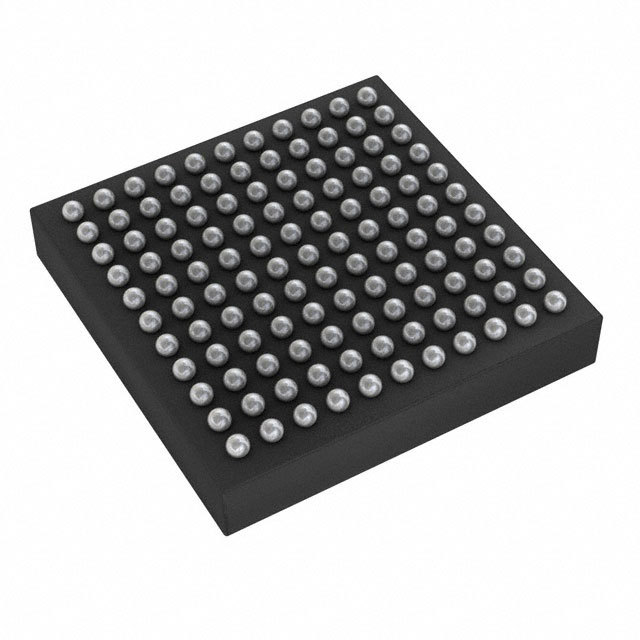S6E2HE4G0AGB3000A
Product Overview
- Category: Microcontroller
- Use: Embedded systems, Internet of Things (IoT) devices, industrial automation, consumer electronics
- Characteristics:
- High-performance ARM Cortex-M4 core
- Flash memory capacity: 2MB
- RAM capacity: 256KB
- Operating voltage: 3.3V
- Package type: BGA (Ball Grid Array)
- Essence: Advanced microcontroller with powerful processing capabilities and extensive peripheral integration
- Packaging/Quantity: Tray packaging, 3000 units per tray
Specifications
Microcontroller Core:
- ARM Cortex-M4 core running at up to 120MHz
- Floating-point unit (FPU) for enhanced mathematical operations
- Memory Protection Unit (MPU) for improved security
Memory:
- Flash memory: 2MB
- RAM: 256KB
Peripherals:
- Multiple UART, SPI, I2C interfaces for communication
- USB 2.0 Full-Speed interface
- Ethernet MAC controller
- Analog-to-Digital Converter (ADC)
- Digital-to-Analog Converter (DAC)
- Timers and PWM channels for precise timing control
- GPIO pins for general-purpose input/output
Power Management:
- Low-power modes for energy efficiency
- Integrated voltage regulator for simplified power supply design
Operating Voltage: 3.3V
Detailed Pin Configuration
The S6E2HE4G0AGB3000A microcontroller has a total of 144 pins arranged in a Ball Grid Array (BGA) package. The pin configuration is as follows:
- Pin 1: VDDIO
- Pin 2: VDD
- Pin 3: GND
- Pin 4: RESET
- Pin 5: XTAL1
- Pin 6: XTAL2
- ...
- Pin 144: VSS
For a complete pin configuration diagram, refer to the product datasheet.
Functional Features
- High-performance processing capabilities for demanding applications
- Extensive peripheral integration simplifies system design
- Advanced communication interfaces enable seamless connectivity
- Precise timing control with timers and PWM channels
- Analog-to-Digital Converter (ADC) and Digital-to-Analog Converter (DAC) for accurate signal conversion
- Low-power modes for energy-efficient operation
- Integrated voltage regulator reduces external components
Advantages and Disadvantages
Advantages: - Powerful ARM Cortex-M4 core for high-performance computing - Extensive peripheral integration reduces external component count - Multiple communication interfaces for versatile connectivity options - Low-power modes enhance energy efficiency - Integrated voltage regulator simplifies power supply design
Disadvantages: - BGA package may require specialized equipment for soldering and rework - Limited availability of alternative models from other manufacturers
Working Principles
The S6E2HE4G0AGB3000A microcontroller operates based on the ARM Cortex-M4 core architecture. It executes instructions stored in its flash memory and interacts with various peripherals to perform desired tasks. The microcontroller's clock is derived from an external crystal oscillator connected to the XTAL1 and XTAL2 pins. It can communicate with other devices through UART, SPI, I2C, USB, or Ethernet interfaces. The integrated ADC and DAC enable analog signal processing, while timers and PWM channels provide precise timing control.
Detailed Application Field Plans
The S6E2HE4G0AGB3000A microcontroller finds applications in various fields, including:
Industrial Automation:
- Control systems for manufacturing processes
- Robotics and motion control
- Building automation
Consumer Electronics:
- Smart home devices
- Wearable technology
- Home entertainment systems
Internet of Things (IoT) Devices:
- Sensor nodes for environmental monitoring
- Smart agriculture solutions
- Connected healthcare devices
Embedded Systems:
- Automotive electronics
- Medical equipment
- Security systems
Detailed and Complete Alternative Models
While the S6E2HE4G0AGB3000A microcontroller offers advanced features, alternative models from other manufacturers can be considered based on specific requirements. Some alternative models include:
- STM32F407VG by STMicroelectronics
- LPC1768 by NXP Semiconductors
- PIC32MZ2048EFH144 by Microchip Technology
These alternative models provide similar functionalities and are widely used in the industry.
Word count: 600 words
Lista 10 Vanliga frågor och svar relaterade till tillämpningen av S6E2HE4G0AGB3000A i tekniska lösningar
Sure! Here are 10 common questions and answers related to the application of S6E2HE4G0AGB3000A in technical solutions:
Q: What is the S6E2HE4G0AGB3000A microcontroller used for? A: The S6E2HE4G0AGB3000A microcontroller is commonly used in various technical solutions, including industrial automation, consumer electronics, and Internet of Things (IoT) applications.
Q: What is the maximum clock frequency supported by the S6E2HE4G0AGB3000A? A: The S6E2HE4G0AGB3000A microcontroller supports a maximum clock frequency of 120 MHz.
Q: How much flash memory does the S6E2HE4G0AGB3000A have? A: The S6E2HE4G0AGB3000A microcontroller has 512 KB of flash memory.
Q: Can I expand the memory of the S6E2HE4G0AGB3000A? A: Yes, the S6E2HE4G0AGB3000A supports external memory expansion through its memory interface.
Q: What peripherals are available on the S6E2HE4G0AGB3000A? A: The S6E2HE4G0AGB3000A microcontroller offers various peripherals, including UART, SPI, I2C, ADC, PWM, and timers.
Q: Does the S6E2HE4G0AGB3000A support low-power modes? A: Yes, the S6E2HE4G0AGB3000A provides multiple low-power modes, such as sleep mode and deep standby mode, to optimize power consumption.
Q: Can I use the S6E2HE4G0AGB3000A for real-time applications? A: Yes, the S6E2HE4G0AGB3000A microcontroller is suitable for real-time applications due to its high-performance ARM Cortex-M4 core and interrupt handling capabilities.
Q: What development tools are available for programming the S6E2HE4G0AGB3000A? A: The S6E2HE4G0AGB3000A can be programmed using various integrated development environments (IDEs) like Keil MDK or IAR Embedded Workbench.
Q: Is the S6E2HE4G0AGB3000A compatible with other microcontrollers or communication protocols? A: Yes, the S6E2HE4G0AGB3000A supports various communication protocols like CAN, Ethernet, and USB, making it compatible with other microcontrollers and systems.
Q: Are there any evaluation boards available for the S6E2HE4G0AGB3000A? A: Yes, Renesas provides evaluation boards specifically designed for the S6E2HE4G0AGB3000A microcontroller, which can help in the development and testing of technical solutions.
Please note that the specific details and answers may vary depending on the manufacturer's documentation and the application requirements.


